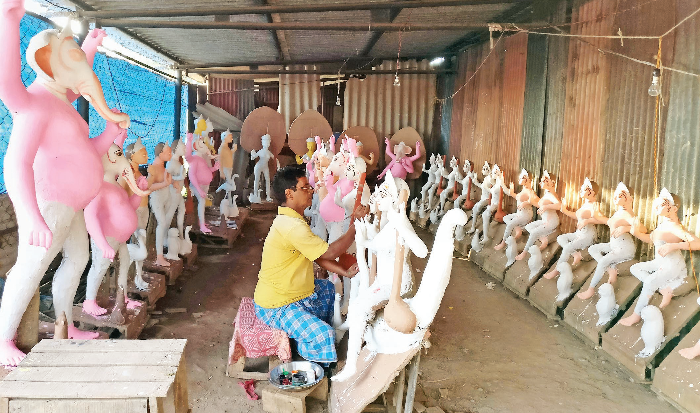Inside a shed at Sancoale Industrial Estate (SIE) lies a small group of Bengali artisans, working overtime for the past three months to cater to a key aspect of a festival observed by Bengali communities across the State.

VASCO
The five-day Durga Pooja festival, observed by Bengali communities to mark Goddess Durga's battle against the demon Mahishasura, will begin on September 25.
Specialised artisans and craftsmen hailing from West Bengal are in the State to prepare Goddess Durga idols inside a SIE shed at Zuarinagar.
Dilip Pal, who heads the group of five artisans, told The Goan that they have received many orders for Durga idols. "For the first time, we will make an idol for a Bengali society in Karwar," said Pal.
Hailing from Kolkatta, Pal has been in Goa since the last three months and at work in the shed sponsored by Kamat Cranes in Sancoale. "We are the only artisans catering to all Bengali communities in Goa," said Pal. "For two decades, we come from West Bengal three months ahead of the festival and begin our work June," said Pal.
Detailing the nature of his work, Pal explained: "Making idols is a time-consuming task, involving patience, mental and physical stamina. We have many orders to complete by Panchami on September 25." "There are no fixed working hours. The closer we get to Durga Puja, the more hectic is our work. We have no outing or roaming around in the city. We don't leave our shed."
"We struggle a lot to adjust and we feel homesick. We miss the fun and excitement in our home town."
Pal, who grew up watching his father at work, says traditional artisans have eye problems at a young age as they have to focus on minute details on the idol.
"In our profession, cough and cold is a common issue as we work in damp conditions and work with wet clay. I would not encourage my children to pursue this profession."
Pal said their biggest challenge in Goa was working in unpredictable weather. "It rained heavily these days and the idols took a lot of time to dry," Pal said.
Commenting on the raw materials, Pal explained that clay is sourced from Mardol, while other materials are brought from Kolkata. "The clay available in Goa is not as good as the clay in Bengal," admitted Pal. Sharing a lesser known secret, Pal said clay for the idol has to be compulsorily mixed with soil sourced from the ground of red-light areas or Nishiddho Pallis (forbidden territories).
"Without mixing this soil with clay, we cannot begin idol-making nor will the Durga Pooja be considered complete. Mud from those areas are sold in Kolkata markets at exorbitant rates and we get this mud specially from Kolkata by transport."
"With demonetisation and GST, the cost of raw materials and transportation has increased two-fold," he added.
Despite the difficulties, Pal is content with his work. "Despite my modest profit, I firmly believe my family and I get blessings of Goddess Durga for my job," says Pal with a smile.
